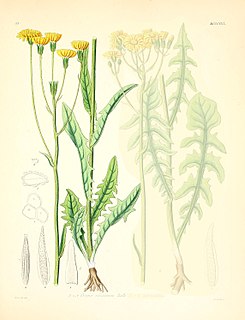
The smooth hawksbeard, Crepis capillaris, is a species of flowering plant in the dandelion tribe within the sunflower family, native to Europe. It has become naturalized in other lands and is regarded as a weed in some places.

Crepis acuminata is a North American species of flowering plant in the daisy family known by the common name tapertip hawksbeard. It is native to the western United States where it grows in many types of open habitat.
Crepis bakeri is a species of flowering plant in the daisy family known by the common name Baker's hawksbeard. It is native to the western United States where it grows in many types of mountain and plateau habitat. It is found in Oregon, Washington, Idaho, northern California, Nevada, and Utah.

Crepis intermedia is a North American species of flowering plants in the daisy family known by the common name limestone hawksbeard. It is native to the Pacific Northwest, Columbia Plateau, Great Plains and Southwestern regions of western North America.

Crepis modocensis is a species of flowering plant in the daisy family known by the common name Modoc hawksbeard.

Crepis occidentalis is a North American species of flowering plant in the daisy family known by the common names western hawksbeard, or largeflower hawksbeard. It is native to western Canada and the western United States.
Crepis pleurocarpa is a North American species of flowering plant in the daisy family known by the common name nakedstem hawksbeard. It is native to the western United States (Washington, Oregon, northern California and western Nevada.

Crepis runcinata is a North American species of flowering plant in the daisy family known by the common name fiddleleaf hawksbeard. It is native to western and central Canada, the western and central United States and northern Mexico (Chihuahua).

Crepis paludosa, the marsh hawk's-beard, is a European species of plants in the dandelion tribe within the sunflower family. It is widespread across much of Europe with isolated populations in Iceland, the Ural Mountains, and the Caucasus.

Crepis tectorum, commonly referred to as 'the narrowleaf hawksbeard' or 'narrow-leaved hawk's-beard', is an annual or winter annual plant between 30 and 100 centimetres in height. Originating in Siberia before being introduced to Canada in 1890, the Narrowleaf hawksbeard's is an invasive species. Maintaining one branched, hairless and leafy stem during maturity, the Narrowleaf hawksbeard has yellow leaves which are arranged in an alternate manner and less than 0.5 inches (13 mm) wide.
Crepis atribarba is a North American species of flowering plant in the daisy family known by the common names slender hawksbeard and dark hawksbeard. It is native to western Canada and the western United States It has been found in British Columbia, Utah, Washington, Oregon, Nevada, Idaho, Alberta, Montana, Wyoming, Colorado, Saskatchewan, and Nebraska.

Crepis barbigera is a North American species of flowering plant in the daisy family. It is native to the northwestern United States. It has been found in Washington, Oregon, and Idaho.

Crepis biennis is a European species of flowering plant in the daisy family with the common name Rough Hawksbeard. It is native to Europe and Asia Minor, as well as being sparingly naturalized in scattered locations in the northeastern United States and on the island of Newfoundland in eastern Canada. Many people think that they are dandelions because they look so alike but that is only because both are in the daisy family.

Crepis bursifolia is a European species of flowering plant in the daisy family with the common name Italian hawksbeard. It is native to southern Europe, as well as being sparingly naturalized in California.

Crepis foetida is a European species of flowering plant in the daisy family with the common name stinking hawksbeard. It is widespread across much of Europe and Siberia, as well as being sparingly naturalized in scattered locations in the United States and Australia.

Crepis nicaeensis is a European species of flowering plant in the daisy family with the common names French hawk's-beard and Turkish hawksbeard. It is widespread across much of Europe, as well as being sparingly naturalized in scattered locations in the United States and Canada.

Crepis pannonica is a European species of flowering plant in the daisy family. It is native to eastern Europe and the Caucasus, as well as being sparingly naturalized in the State of Connecticut in the northeastern United States.

Crepis rubra is a European species of flowering plant in the daisy family with the common name red hawksbeard or pink hawk's-beard. It is native to the eastern Mediterranean region and is widely cultivated as an ornamental. It became naturalized in a small region of the United States.

Crepis vesicaria is a European species of flowering plant in the daisy family with the common name beaked hawk's-beard. It is native to the Western and Southern Europe from Ireland and Portugal east as far as Germany, Austria, and Greece. It became naturalized in scattered locations in North America.

Crepis sibirica, is an Asian and eastern European species of plants in the dandelion tribe within the sunflower family. It has been found in China, Mongolia, Russia, Central Asia, and eastern Europe.

















